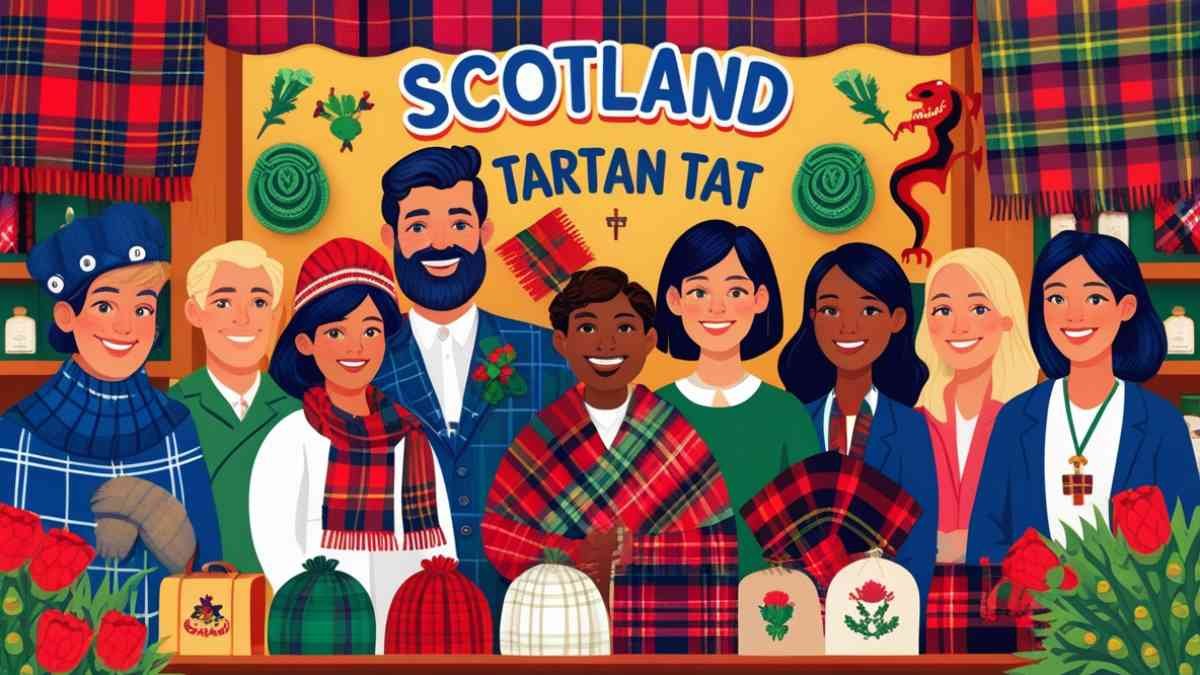Tartan Tat: Understanding Scotland’s Love–Hate Relationship with Tourist Souvenirs

Scotland’s cultural identity is famously wrapped in the vibrant patterns of tartan. From the deep greens and rich reds of clan kilts to the understated elegance of muted plaid scarves, tartan represents a long and complex history. Yet alongside the revered tradition exists a less flattering phenomenon often referred to as tartan tat. This phrase has become shorthand for the cheap, mass-produced souvenirs that trade on Scotland’s heritage without the craftsmanship or authenticity that true tartan deserves. Exploring the origins, impact, and cultural debate surrounding tartan tat reveals how a centuries-old symbol has become both a source of pride and a target of criticism.
The Origins of Tartan and Its Global Appeal
To appreciate why tartan tat sparks such strong feelings, it helps to understand the historical weight of tartan itself. Woven from wool and distinguished by distinctive criss-crossed patterns called “setts,” tartan originally denoted regional identity in the Scottish Highlands. By the eighteenth century, it had become linked to specific clans, a practice reinforced by romanticised nineteenth-century writers and royal patrons such as Queen Victoria and Prince Albert, who famously embraced Highland dress at Balmoral Castle. This royal approval propelled tartan into global fashion. From aristocratic drawing rooms to Hollywood sets, tartan came to symbolise the rugged charm and proud independence of the Scots. With that popularity came commercial opportunity, and eventually the rise of products that exploit the image without necessarily respecting the tradition.
Defining Tartan Tat
The phrase “tartan tat” is used by Scots and seasoned travellers to describe the flood of cheap, imported goods decorated with tartan patterns. These items often include plastic bagpipes, novelty kilts, keyrings, mugs and hats—objects sold in tourist districts such as Edinburgh’s Royal Mile or the bustling streets of Inverness. The word “tat” itself is a British colloquialism for something of little value or poor quality. Combined with tartan, it forms a wry critique: souvenirs that may carry the pattern of Scottish heritage but lack the heart and skill of genuine Scottish craft.
Locals who cherish authentic kiltmaking and traditional weaving see these goods as caricatures of their culture. The bright but synthetic fabrics and mass-production methods often have no connection to the mills of the Highlands or the meticulous artistry of true tartan weaving. Instead, the products are typically imported, sometimes from factories far from Scotland, and marketed simply to capture the wallets of visitors seeking a quick memento.
The Economics of Souvenir Culture
It is easy to dismiss tartan tat as merely frivolous, yet the tourist trade is a vital part of the Scottish economy. Visitors flock to the country for its dramatic landscapes, historic castles and lively festivals, and many want to take a piece of Scotland home. For shops along major tourist routes, tartan-themed trinkets provide reliable revenue. Bright displays of kilts and scarves draw in crowds, and low prices make them accessible to all. From the perspective of merchants and some travellers, tartan tat is simply a convenient way to commemorate a trip.
However, this commercial success also creates tension. Traditional weavers and reputable kiltmakers find it hard to compete with bargain-basement prices. Their painstakingly hand-crafted garments, often using pure new wool and centuries-old techniques, cost far more than a polyester kilt produced in bulk. When tourists fail to recognise the difference, authentic producers may be overshadowed by cheaper imitations. Over time, the prevalence of tartan tat can dilute the perceived value of true Scottish craftsmanship.
Cultural Identity and the Tartanry Debate
The existence of tartan tat feeds into a broader discussion often called “tartanry,” the idealised or even exaggerated representation of Scottish culture. From nineteenth-century literature to contemporary tourism campaigns, Scotland has sometimes been portrayed as a land of eternal bagpipes, misty glens and heroic Highland warriors. While these images can be charming, critics argue they reduce a complex nation to a handful of clichés.
Tartan tat embodies the most superficial side of tartanry. When a culture is packaged into easily digestible symbols, it risks losing the subtlety and diversity that make it unique. Younger Scots and cultural historians alike question whether the constant parade of novelty kilts and plastic bagpipes truly honours the spirit of their ancestors or simply entertains visitors. At the same time, many Scots take a pragmatic view, recognising that the romantic image of the Highlands—however exaggerated—has helped draw global attention and investment.
The Tourist’s Perspective
For travellers, the allure of tartan tat can be hard to resist. A mug patterned in bright red plaid or a soft toy dressed in a miniature kilt offers a quick, cheerful souvenir of a holiday in Scotland. These inexpensive keepsakes are easy to pack and share with friends back home. Moreover, not every visitor has the budget or knowledge to invest in a bespoke tartan garment.
Still, thoughtful travellers often seek ways to support authentic artisans. Local weaving mills, independent kiltmakers and family-run shops provide high-quality alternatives. By purchasing from these sources, tourists can help sustain traditional skills and ensure that tartan remains more than just a decorative pattern. Understanding the distinction between authentic craft and mass-produced tat empowers visitors to make more informed choices.
Efforts to Preserve Authenticity
Across Scotland, organisations and communities work to protect and promote genuine tartan craftsmanship. From the Scottish Register of Tartans, which records officially recognised patterns, to long-standing mills in the Highlands and the Borders, there is a concerted effort to maintain high standards. Festivals and cultural events often feature demonstrations of weaving, giving visitors a deeper appreciation of the skill involved.
These initiatives highlight the difference between tartan as a living tradition and tartan tat as a superficial imitation. They encourage both locals and tourists to value quality over quantity and to see tartan not merely as decoration but as a vibrant part of Scottish heritage.
The Double-Edged Sword of Global Popularity
Ironically, the very popularity that has cheapened tartan has also ensured its survival. International fashion designers frequently revisit tartan in their collections, and global interest helps keep Scottish weaving relevant. Tartan’s presence on runways and in popular culture proves that the pattern remains a dynamic symbol of style. Yet every revival risks inspiring a new wave of low-cost imitations, perpetuating the cycle of tartan tat.
This duality is emblematic of many cultural symbols worldwide: the more they capture the imagination of outsiders, the more they risk being simplified or commercialised. For Scotland, the challenge lies in balancing the economic benefits of tourism with the responsibility to safeguard its cultural legacy.
Moving Towards Conscious Consumption
The debate over tartan tat ultimately raises a larger question: how should a nation present its heritage to the world? It invites visitors to look beyond surface impressions and to respect the communities behind the symbols. Conscious consumption—choosing authentic, locally made products—can transform souvenir shopping into an act of cultural preservation.
For locals, too, the discussion serves as a reminder that cultural symbols are not static. By continuing to weave new patterns, experiment with sustainable materials and educate future generations, Scotland can ensure that tartan remains a living tradition rather than a mere stereotype.
Conclusion
Tartan tat is more than a collection of cheap souvenirs; it is a mirror reflecting Scotland’s ongoing negotiation with its own identity. While these brightly coloured trinkets keep tartan visible in the global imagination, they also challenge Scots to protect the authenticity of their heritage. By understanding the difference between mass-produced novelty and genuine craftsmanship, both visitors and locals can honour the true artistry behind tartan. In doing so, they help ensure that Scotland’s most famous fabric remains a symbol of pride and not just another tourist cliché.



